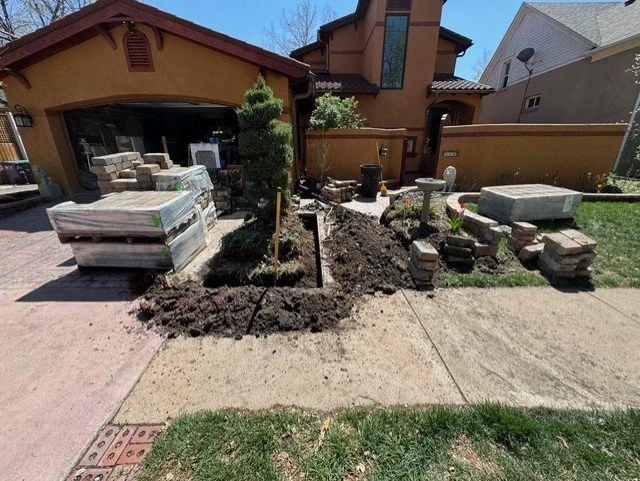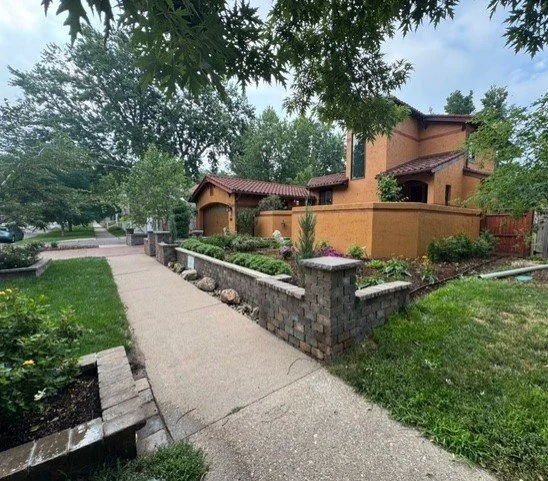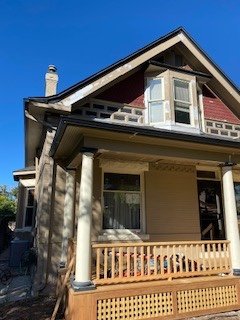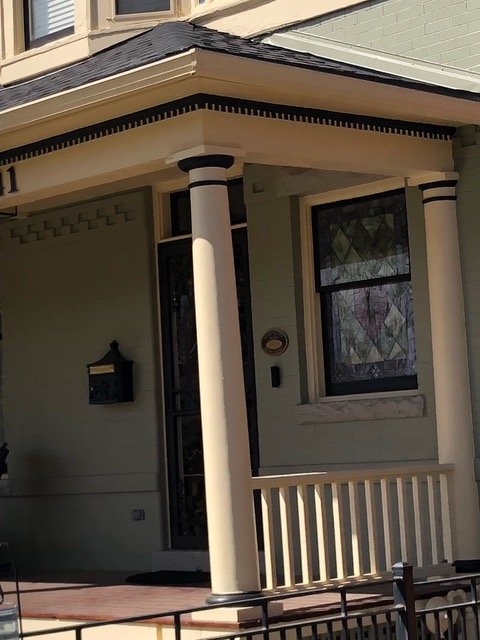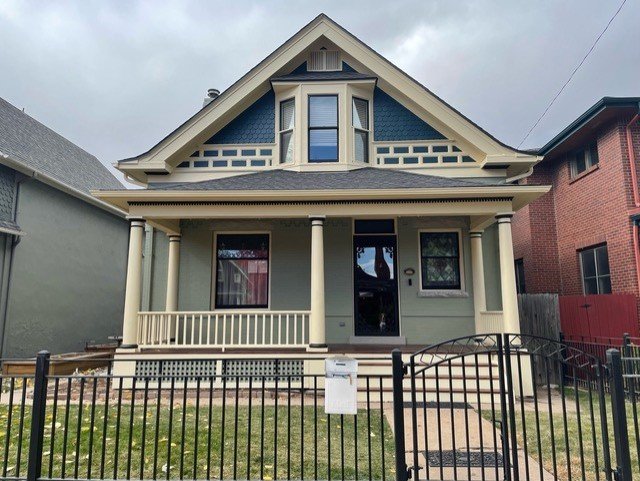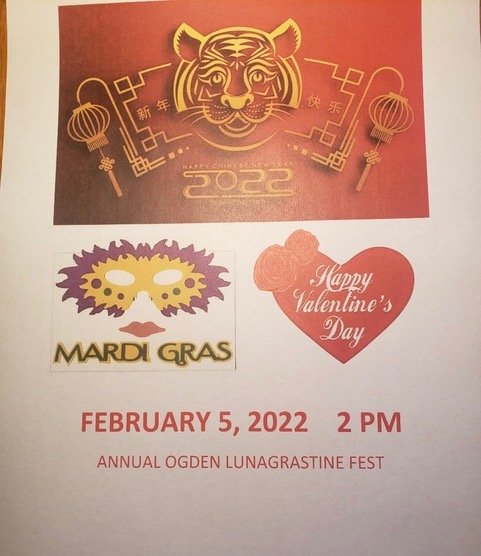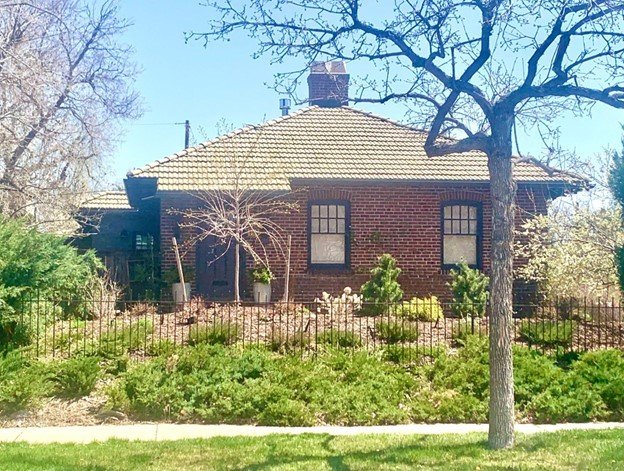2025 Award Recipients
Please enjoy the stories of these Alamo Placita neighbors that shed light on what’s involved in a successful historic preservation project. Additionally, you might feel inspired seeing what neighbors are doing to build community connections.
Joanna Ford, Neighborhood Networker and Community Activist
We all have unique stories about how we came to live in Alamo Placita. Originally from the Bronx and the Hudson Valley, Joanna Ford moved to Denver, and became acquainted with Alamo Placita through her friend Joe Woodward, an enthusiastic organizer in the neighborhood.
Joanna was working at Urban Peak, a center for troubled youth in 2005. It’s where she met her future husband Brian. The two shared a deep commitment to being of service to others. She and Brian liked the energy and friendliness of Alamo Placita, enjoyed visits with Joe Woodward, and eventually purchased a home here.
Joanna started working on her Master’s degree in Community Mental Health Counseling, and eventually worked with people of varying backgrounds and needs. A deep compassion for people from all walks of life grew.
In addition, Joanna came from a family who were very engaged in civic and political action. So over time, she became interested in our City Council’s role in the well-being of neighborhoods, also getting to know our current City Council representatives, being curious about their voting records and projects. These days, she also volunteers and marches for different causes.
Being block captain: A win-win:
In 2013, a neighbor invited Joanna to start being block captains together, keeping the neighborhood list up to date as people moved in and out, then sharing the updated list with neighbors each year. “It’s been a great way to meet neighbors, feel more connected, and also enjoy a friendship with my co-block captain. I’m so glad to see the list is a useful tool for helping neighbors be in touch.”
After Covid, more houses came on the market, and new neighbors started moving in, two households about every 8 months. It seemed that something more than a neighborhood list was needed to help new neighbors become a part of the block.
So Joanna joined two other neighbor friends who started hosting “porch-lawn” parties to welcome new neighbors. The welcome parties became a popular tradition in 2022, 2023, and 2025. New neighbors wrote thank-you’s to organizers to say that, because of the porch-lawn parties, they now felt like they were an integral part of the block.
Joanna’s contributions to the quality of life of neighbors on her block span many years, through her calm presence, generosity, and active involvement. At the same time, her being engaged in the direction of our city’s leaders, looking out for the well being of the whole neighborhood and beyond would make Margaret Mead happy…
“Never doubt that a group of thoughtful, committed citizens can change the world; indeed it’s the only thing that ever has."
How One Couple Has Fostered Warm Community Connections Among Many
If you’ve ever found yourself out for a walk on East 5th Avenue between Emerson and Ogden, you may have noticed the delightful “chicken window” inviting you to take in a view of the happy hens clucking and pecking away. And you may glimpse the inviting fairy garden near the front door where children are drawn to play. In the summer, there are veggies growing on the side of the home that children are encouraged to pick. If you stroll by on a Thursday afternoon around 5:00pm, you’ll see blue stadium chairs in a circle welcoming one and all to stop and visit for a few minutes or a couple of hours. It’s the one-of-a-kind “Chicken Window Happy Hour.”
Who are the lovely and generous-hearted people who have created this oasis of camaraderie in an ever-busy world?…where long-time neighbors and strangers alike are invited and welcomed. Conversation is easy and congenial. People might bring their favorite creation like peach-habanero salsa to share, or their homemade sourdough-cheddar crackers, or a newly-discovered apple cider made in Aurora. Most feel perfectly fine just showing up. All are welcome.
At the happy hour, a collection of baby strollers are scattered along the sidewalk while mothers and fathers share their latest news, discoveries, and challenges. Neighbors from Marion St. to the east and Washington St. to the west eagerly arrive. A guest at the nearby Air B&B drops by to meet locals and enjoy a chat with friendly people. Some regulars come early or stay late and gladly help set up and put away chairs. There’s a sublime uplifting air of acceptance and openness.
As you might guess, the couple who created this on-going invitation to relax with neighbors are big-hearted people who thrive on social contact and conversation. You might not know that Anne and Peter Thulson have been long-time dedicated school teachers. So how did the Thulsons originally find their way to Alamo Placita?
When Peter and Anne Thulson started a family, they bought a H.U.D. house in Observatory Park. By the time they had fixed it up, it had grown too small for their growing clan. So they began to look for a bigger house. They didn’t realize until friends from Alamo Placita told them how neighborly it was here, being so convenient to grocery stores, downtown and beyond. They found and purchased the house in the 90’s where they live today. Currently, Anne can ride her bike or take the bus to Metro where she teaches. So convenient!
The Thulsons’ connection to Alamo Placita actually started with Peter's mother who lived at 525 Pennsylvania St. in the 1930’s. She was part of a Swedish-American community along with Greek-Americans and Danish-Americans who were some of the groups who populated what was then called Arlington Park. Later in the mid-1990’s, Peter and Anne helped historic researchers learn more about the first immigrant groups in Alamo Placita by arranging interviews with his relatives.
When their children were 10, 13, and 16, Anne and Peter took them on a bicycling trip during the summer on a Fund for Teachers grant. During a month, they rode from Rome to Venice. What a life-changing experience for them all, helping their children experience people from all over being friendly and helpful.
No wonder that Peter and Anne’s daughter Maggie was inspired by her parents’ love of teaching. She became a teacher herself. As coincidence would have it, Maggie was the teacher of one the neighborhood children. The father says it was an unforgettable peak experience for his daughter to have Maggie as her teacher, so skilled, so engaging. A wonderful bond was established between Maggie Thulson and his daughter. The dad observed, “The apple doesn’t fall far from the tree."
So how and when did the Chicken Window Happy Hour get its start? Peter and Anne are such outgoing and people-centered neighbors, when Covid hit, they were missing having contact and interaction with people. Peter put up a sign on their fence inviting folks to drop by on a Thursday for happy hour, chairs were set up 6 ft. apart, Peter plopped down a bucket of kids’ and adult beverages. and the gathering was on.
You may wonder how the “window” came about in the name. Anne says that she had the idea for Peter to create an opening or “window” in the fence (close to the height of the chickens). That way, all the children and families walking past could stop and see how “the girls” were doing. Peter covered the opening with a piece of lattice work. Later, someone came up with the idea to nail a metal box with a lid next to the window and the Thulsons kept it filled with food so that children could feed the chickens. A fun, interactive spot for young and old was created in the neighborhood.
So most Thursdays when the weather isn’t too challenging, the Chicken Window Happy Hour happens. Even if rain sputters, the wind picks up, and the temperature drops, people have been to known to stay, continuing their conversations. If it’s early fall, Peter invites the kids to pick something out of his vegetable garden nearby. And he grows pumpkins that he gives away to families for carving at Halloween. Another neighbor Juliet warmly shared that the Thulsons baked her a cake to celebrate the occasion of her becoming a U.S. citizen. And a neighbor Grant says he visits on Thursdays in the winter, and Peter starts a big fire in the back yard pit to stay warm while the conversation flows.
At the Chicken Window Happy Hour, camaraderie happens, relationships have grown, trust has evolved, and new people feel welcomed and can become well-known neighbors. The atmosphere is warm and relaxed. What else could a person ask for? Heartfelt thanks to Peter and Anne Thulson for supporting a genuine sense of community among so many neighbors.
Jack Hermanson, A Mighty Welcome Force in the Neighborhood
In 2022, after college and starting work in the Denver Tech Center, Jack Hermanson had never heard of Alamo Placita. But after a few months of a new life of work “in the ‘burbs’, Jack and his husband just didn’t feel comfortable in the DTC with the scale of the roads, buildings, and impersonal-ness of the area.
So he and his husband explored Denver neighborhoods like S. Broadway, downtown, and Cap Hill. When they stumbled into Alamo Placita, it was just what they were looking for—beautiful big trees and historic homes, convenient shopping and eateries, and a cozy park to tie it all together—a human-scale community for people vs. an impersonal place built to carry traffic through.
Jack had read Bowling Alone by Robert D. Putnam years before about how our health is supported by our community involvement. He practiced the principles of community engagement in college, having goals while also collaborating in groups for great outcomes, keeping an open mind, and practicing constructive communication.
So when he noticed a flyer in his building for the APNA annual meeting, he was thrilled to learn that such an organization existed to support neighbors’ quality of life and safety. He went to the annual meeting and joined the board in the spring 2023.
His enthusiasm, positivity, and good humor were welcomed by the board, and members were glad to hear about his concern and goals for the unsafe corner in the neighborhood…at 5th Ave. and Corona near Safeway. “So many young mothers with strollers and elderly folks and people walking dogs trying to cross there, with cars zooming by at 40 mph.” His energy was infectious with the board as he shared the steps he planned to take to find a solution.
Maybe others have a similar concern about a safety issue in the neighborhood, and are curious about the steps Jack took. He first called 311 where a ticket was assigned to DOTI (Dept. of Traffic and Infrastructure) MANY times, with each ticket being closed summarily by DOTI. So he asked the APNA board to sign on to a complaint which was sent to several high-ranking DOTI officials.
Then a little serendipity happened at the 2024 annual meeting where our new City Councilwoman, Flor Alvidrez spoke. At the end, Jack asked her about the damaged and destroyed street monuments in Alamo Placita and how to get them repaired. Something in his demeanor was inviting and constructive. It was a cordial conversation, and Ms. Alvidrez wrote herself a note. She offered to attend one of the APNA board meetings, maybe a first for a city councilperson.
Our Councilwoman actually attended two meetings, and this afforded time for everyone to get to know each other. A positive connection was made. She encouraged Jack to have persistence with the unsafe corner issue. She also sent one of her staff members to subsequent board meetings and the relationship grew. The staff member put Jack in touch with a contact at DOTI and the DOTI contact person came to a board meeting. Progress!
Jack kept following up with the designated DOTI person, with support from our city council office. Finally, Success! In the spring this year, a crosswalk and sign were installed at 5th and Corona, and cars have slowed down. Please check it out and celebrate our improved safety! Jack was creative, patient and perseverant, calm but insistent. And it paid off—with the input and help of several groups. The author of Bowling Alone was right: working in cooperation with several groups and agencies is much more effective and their support helps us stay enthused and persistent.
In the meantime, Jack was also updating the APNA website and sending APNA news in emails to the neighborhood. Much needed and appreciated! He also volunteered to organize a community neighborhood cleanup day in September 2024.
He designed an attractive announcement card and found a grant to get them printed and mailed for free.
He contacted the Parks Dept. who provided mulch and equipment to spread the mulch around trees. He located funding to provide food for the participants.
It was a great opportunity for everyone to meet and get to know neighbors, including some new neighbors, helping people feel more connected to each other.
Last, over time, Jack has established a robust and effective working partnership with our City Councilwoman through her staff members. He has been instrumental in helping obtain the funding for two street monuments (at cross streets and Speer) to be rebuilt, the funds offered by city councilwoman Flor Alvidrez.
Jack is a delightful addition to our neighborhood. He lives community activism. He’s a role model for us in the way he takes the initiative and has the heart to persistently follow through with projects that benefit the whole neighborhood. We deeply appreciate Jack Hermanson and his contributions.
Jerred Lane, multi-talented home project designer and builder, plus
Our only nominee this year for a renovation project is well-known and appreciated on his block
and beyond. He’s an aerospace engineer; so you might picture MacGyver from the TV series, seemingly able to solve most any problem using physics, the laws of nature, energy dynamics… It seems to me that engineers are able to understand the inner workings of the physical and energetic world in a way most of us don’t. What a gift!
Not only is Jerred Lane gifted in a variety of ways, he’s also generous-hearted with friends and neighbors, helping solve any number of neighbors’ property issues, even building a “little library” for a neighbor who had been wanting one for her front yard.
Originally living in Wash Park, Jerred first noticed the 1979 Mediterranean-style show home at 916 E. 5th Ave. about 25 years ago, admiring how well it was designed and constructed. Over the years, he met and became good friends with the owner and his relatives. He admired how the house sat on the property, the different views of nature from all the windows, the abundant light throughout the house. When the original owner decided to move out of “the big city” in 2016, Jerred offered to buy the house.
The first issue that Jerred wanted to address was the sinking garage caused by a constant “pond” of water in the alley. Being an engineer, Jerred had a pretty good idea about the reason for the sinking. It was water seeping down into the soil eroding the foundation, and he knew what the permanent solution would be—to drill piers into the soil til contacting bedrock or enough pressure to hold the piers in place. The last step was to use the piers as leverage to lift the garage back to a level position. No small feat! After the garage level was corrected, he worked with the City helping them see their responsibility and liability to correct the pond issue in the alley, especially since he had gone to the expense to correct the garage sinking caused by the pond. The City agreed and fixed the pond issue permanently, which also helped his neighbor on the other side of the alley.
Next, Jerred turned his attention to the front yard of the house wanting to create an elegant and attractive finished look to the front of the house…with defining walls and planters, lots of perennial color and interest, employing low water and low maintenance principles.
Knowing that water drainage was the first thing to address, he designed four French drains to handle the run-off from the roof. He also worked with a neighbor architect who drew up a design for the walls and planters that would reflect the Mediterranean motif of the home.
He submitted his plans to the City via the permitting process. The City quibbled over the plans for the French drains, and Jerred, with his engineering background, was able to explain to the City the design and math he employed, and the City then accepted his plans. (Jerred explained that the City uses guidelines and mathematical calculations that work very well for most projects, especially for those of us who don’t have a background in engineering.)
Once the permitting process was a “go”, Jerred filed an application with the Denver Landmark Commission, and after some discussion, work began. To clarify, Denver Landmark gets involved in exterior changes involving construction and “hardscaping", but doesn’t have purview over plant material or plantings. So if you want to convert parts or all of your lawn to xeriscaping, it does not require Landmark’s involvement.
Two large planter boxes were built in the parkway (between the street and sidewalk), along with two other planter boxes near the home, with a wall along the sidewalk to create a visual container for the perennials between the wall and the home.
Asked whether he likes living in an historic district (with the extra guidelines and involvement of Landmark for exterior projects), he responded most positively. He admires the lasting integrity of the historic homes in Alamo Placita (versus all the teardown of original homes and McMansions built in their place, for example in Cherry Creek and Wash Park). Jerred also appreciates the unique neighborliness that is characteristic here, along with the Neighbors Association actively advocating for historic preservation.
Jerred and his infectious energy are a major contribution to the neighborhood, empowering other homeowners to learn and understand how to repair or enhance their property. Being friendly and being outdoors working on different projects, interacting naturally with neighbors, he’s a positive force in Alamo Placita. He helps “de-mystify” a project for most of us homeowners who aren’t builders or engineers, helping us see what’s involved in a project. He’s a model for us helping us imagine how we might make positive changes around our own home.
Hardworking and contented homeowner Jerred Lane enjoying his finished project at 916 E. 5th Ave
If you’re curious about drainage issues and foundation problems and solutions, here’s a video of TV host and narrator Mike Rowe on the job, sharing an honest view of the whole process: If you’re curious about drainage issues and foundation problems and solutions, here’s a video of TV host and narrator Mike Rowe on the job, sharing an honest view of the whole process: https://youtu.be/rqCBGcumqjc?si=03yFuRIl-xqlrobv
2024 Award Recipients
Learn about the 2024 Partners in Preservation recipients below.
Restoration of Tree-Damaged Front Porch at 650 N. Downing Street
When Jared Coffin and Kate Miyamoto were looking for a home, they really wanted to be in a neighborhood with historic homes. In 2011, they were able to purchase a home at 650 N. Downing. The home was constructed in 1905 and extensively remodeled in 2012. They are a family of four now with their two young children.
In October of 2020 they were unfortunate to have a giant tree limb fall on the house, causing extensive structural damage to the porch as well as a portion of the house. The damage to the porch included the facia, soffits, and both double-column brick supports.
After much back-and-forth contact with the city building department, the Landmark Commission and the selection of a contractor, they were able to begin restoration. This laborious preparation process took a period of 12 months.
The damaged porch was completely disassembled. All brick work was taken down piece by piece to preserve the original grey-speckled brick.
The double-column brick supports were reconstructed with added reinforcement to comply with current building codes.
The porch decking and steps were replaced with concrete. A damaged front corner of the house was repaired as required.
The main porch beam was rebuilt with steel reinforcement to meet current codes as well. The porch roof was reconstructed with compliant materials.
Many components of the porch’s architectural front façade were salvaged and reused. Some components needed to be fabricated.
Please notice in the photo the salvaged vertical wooden details on the right in dark color, with the two newly-fabricated vertical wooden details on the left in a light color.
The finished project was painted the same as the original porch with colors matching other details of the house. The front landscaping was replaced.
This entire project took a period of 18 months. With meticulous attention to detail and a profound respect for the home's historical significance, the renovations have breathed new life into the structure while maintaining its intrinsic character.
2022 Award Recipients
Learn about the 2022 Partners in Preservation recipients below.
Story of a New Historic Porch and Paint Colors at 441 Pearl St.
Angelique and Justin Gault were very happy to find and purchase the home at 441 Pearl St. in March of 2020. They’d always wanted to live in a historic district, and looked forward to honoring and enhancing the historic nature of their home that was built in 1901.
Before the renovation…
After standing for 50-60 years, one corner of a previous front porch construction had begun to sink as the result of structural deterioration. Upon examination it was revealed that the porch foundation was in need of major repair.
For their biggest project so far, the porch reconstruction, they worked with a contractor-builder in the design of the porch. Then they submitted their plans to Landmark for approval, and with back-and-forth discussions (during Covid), the approval process took a total of about three months. Most people could probably expect projects that involve replacing the existing structure to progress more quickly.
In the meantime, the Gaults began working with a historic preservation colorist for help in choosing the colors for the exterior of the home. When Landmark asked for their plans for color changes on the porch and the rest of the home, the Gaults submitted those plans.
The Porch
The original pillars, the covered porch, and bead board ceiling of the porch were preserved. The porch and porch stair height were kept the same. The height of the side balustrades was lowered to align to the lower sill of the front window, as recommended by the historic preservationist. A front balustrade was added. Pressure-treated wood was not used for the construction of balustrades, but instead pine. Cedar was used for the porch decking, which was stained to reflect the wood tones of the front door. Lattice, custom-created with cedar, was designed to align with historic and aesthetic values, with vertical lines being predominant. The original dentil molding was preserved and painted black to create an attractive contrast.
Balustrades lowered to align with window sill edge.
Dentil molding painted black for contrast.
1940s Newspaper Found
While prepping for paint around the upstairs bay window, 1940s newspaper was found insulating the window, with signs of smoldering fire in the past. Newspaper was removed and the area was properly insulated and painted.
Historic Paint Colors
The paint colors for the exterior of the house and garage were selected to reflect the period of the home, using Benjamin Moore's "Historic Color" collection. Louisberg Green was chosen as the main color of the brick, with Newburg Green as the secondary body color for the scalloping and shingles found on the gables and dormers. StandishWhite and black were used for the trim to highlight some of the architectural features. And, lastly, Rockport Gray was used on the masonry stone to mimic the original limestone.
The renovated porch sporting lower balustrades, lattice work instead of skirting, and a historically-based color palette.
Many congratulations to Angelique and Justin Gault for their extensive planning and well thought-out decisions. Their preservation accomplishments greatly enhance the historic nature of the property and serve as a beautiful example of preservation for the neighborhood to enjoy for years to come.
The Gaults' insights and tips for working with Landmark
Because we made aesthetic changes to the porch at the time of planning (lattice for the skirting, lowered side balustrades, additional front balustrade) our submission had to be referred to the committee for review. Our deck contractor appeared on the committee’s review day and walked them through the plans (what was the same, what was different) and used our preservationist’s website content to help illustrate and justify the reasons for the changes, which were designed to make the house’s architectural features be more authentic to the time period.
Due to the changes we made on the construction of the porch as well as the historic colors we chose, we strongly suspect that it helped us receive full approval on our plans without any back and forth.
One big thing we learned (and did not know going into the project) was how critically important the color placement is. Our preservationist had many “before and after” examples on his website to help illustrate what a difference color placement makes on a home with historic architecture.
Our paint consultation with the preservationist was done via zoom and cost less than $200 (in 2021), but it was so incredibly worth it. Exterior painting is expensive, so the added cost of a consultant may seem daunting, but we were SO much happier with the colors we chose in the end, compared to what we had been considering before we met with him. The historic preservation colorist was also the one who suggested changing the solid skirting to lattice and lowering the balustrade, giving us the architectural reasons for why it would make the house be more authentic to its period.
Our consultant: Ken Roginski of The Old House Guy (oldhouseguy.com) 732-455-9499
Ted Swan, Team Player, Natural Leader, and Outgoing Neighbor
Ted Swan of 516 Ogden St. will be the first to tell you that he lives on a very friendly block of activity-loving and people-loving neighbors. They nominated Ted for this award because of his tremendous warm and welcoming nature that has brought people together in new and bigger ways.
While waiting to pick up his daughter at kindergarten, he introduced himself to another waiting parent. They were pleasantly surprised to learn that they only live two blocks apart. They exchanged contact information, and he invited the family to the next Ogden St. event, introducing them around to neighbors. Now that family is part of the “Ogden family.”
Ted is a natural…starting conversations with strangers, welcoming new people to neighborhood parties, adding to the sense of community…all while helping organize multiple events. These Ogden neighbors host events for young and old, bridging generations. This year, Ted and neighbors hosted a February multi-cultural block party that included a Mardi Gras celebration with tossing treats, toys, and trinkets from a balcony to excited neighborhood children waiting below, with delighted parents and neighbors enjoying the fun too.
Valentine’s Day was also celebrated at the February block party with decorated houses along with an exchange of Valentine cards and candy.
At the block party, they also celebrated Chinese New Year, authentically sharing “the red envelope” tradition with dollar bills inside to wish friends a healthy and prosperous new year, all with houses decorated in a Chinese theme.
Here’s the invitation to the February block party. Have you ever heard of the “Lunagrastine Fest”?
When you figure the name out, if you’re like me, you’ll laugh out loud at the fun creativity of this group.
Ted and his community spirit were also a big part of the Easter Egg hunt for neighborhood kids over the last few years.
During the pandemic, Ted and neighbors were still active, keeping connections going with a summer 2021 block party with air castle and other activities that attracted all generations.
Deep appreciation to Ted for his warm, inclusive, engaging spirit that has such a positive effect on his neighbors and beyond.
Long-time Architect Integrates New Addition
In 2018, architect Candy Roberts and her husband Andy Roberts were thrilled to find and purchase an historic home in Alamo Placita. This private residence at 1111 East 3rd Avenue, Denver, CO was built in 1918.
The “before” view from East 3rd Ave. in 2018
Candy Roberts is an architect in Colorado who has worked on many Historic Preservation projects. Candy was a founding partner in the architectural firm “Semple Brown Roberts”, now “Semple Brown Design”, who are proudly celebrating their 40-year anniversary. Andy Roberts has Historic Preservation experience serving as an advisor for the National Trust for Historic Preservation for nearly a decade as well as in the restoration of several significant historic buildings in downtown Denver.
The Roberts hired architect Bob Wacker to join Candy in the design and documentation of the home renovation and restoration and Peter Monroe, Structural Engineer, with IMGE Engineers.
Candy Roberts developed the overall vision and design for the property. This included an open area on the south (3rd Ave) as an outdoor gathering and dining area. The garden has a south / west orientation which is adjacent to the pedestrian traffic from the Denver Country Club Neighborhood from the east, into the Alamo Placita Neighborhood and Park to the west.
New gathering and dining area, 2022
The Roberts wanted to find the exact roof tile from the original house. The original distinctive profile of the flat interlocking roof tiles (vs. more common barrel-shaped tiles) is no longer made. However, the General Contractor, Lifehouse Construction, searched and found a demolition underway that had the exact same flat interlocking roof tile. The tile was purchased and used for the Roberts’ home expansion. It was a big win to find matching tile for an historic building. From the Roberts’ point of view, the roof is one of the most attractive and prominent design characteristics of their home.
View from East 3rd Ave. in 2022 with replicated roof tiles
To distinguish between what is historic construction and what is new is the goal of historic preservation. The design of the addition replicates the architectural features of the original 1918 design. All the original roof details, the window proportions and divisions of the glass window and door mullions and their placement were all considered carefully as a nod to the historic look.
The owners desired that the exterior wall of the addition be built of masonry, feeling that keeping the same material would strengthen the architectural integrity of the home. However, the Design Guidelines for the Denver Landmark Structures and Districts required the addition be clad in four-inch, painted lap siding exterior which the Roberts followed.
The original exterior painting had of course been altered over the years. The color scheme of the house when they purchased it felt too busy to the Roberts. They chose one color for the exterior walls feeling it more complimentary to the classic historical composition.
Fortunately, the existing building foundation and site drainage did not cause any construction concerns.
The Roberts were delighted with their General Contractor. The Roberts found Lifehouse Construction exemplary in their professionalism, attention to detail, historical home renovation experience and construction skills incredibly important to the success of this project. Having a knowledgeable contractor to navigate the City and County of Denver governing agencies was extremely valuable. The Roberts strongly believe that choosing an experienced contractor was key to the success of their project.
Approvals were needed by the Landmark Commission to move forward with the construction. The most impactful change was the need to add a garage (none existed) and additional square footage to the master bedroom. The approval process was challenging at times but in the end, the outcome was a success.
The Roberts said they would be honored to share with the community their renovation experience to support saving more of the extraordinary historical architecture of the neighborhood. Indeed, the Roberts have made a great contribution to the integrity, beauty, and history of Alamo Placita and Denver.
The “before” view of front entrance on Corona St., 2018
The “after” view of front entrance, 2022
















